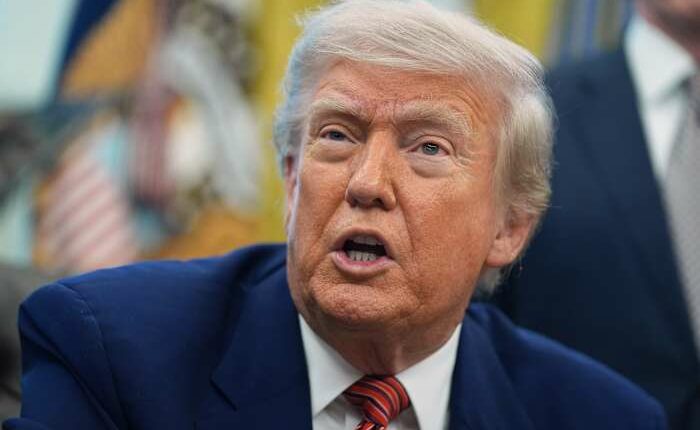Share this @internewscast.com

BRIDGEWATER, N.J. – President Donald Trump on Saturday announced he’s levying tariffs of 30% against the European Union and Mexico starting August 1.
Trump revealed plans for new tariffs targeting two of the United States’ largest trading partners through letters shared on his social media platform. This move is part of a series of tariff announcements directed at both allies and adversaries, which form a key aspect of his 2024 campaign. He claims these tariffs will help rejuvenate the U.S. economy, which he argues has been exploited by other countries for many years.
In the letter addressed to Mexico’s leadership, Trump acknowledged the country’s role in curbing the flow of undocumented migrants and fentanyl into the U.S. Nonetheless, he criticized Mexico for insufficient efforts in preventing North America from becoming a “Narco-Trafficking Playground.”
“Mexico has been helping me secure the border, BUT, what Mexico has done, is not enough,” Trump added.
Trump in his letter to the European Union said that the U.S. trade deficit was a national security threat.
Regarding the European Union, Trump expressed that discussions about the trading relationship have been ongoing for years. He concluded that it’s time to address the substantial and persistent trade deficits caused by the EU’s tariffs, non-tariff measures, and trade obstacles. Trump noted that the relationship has regrettably not been equitable.
EU responds
European Union Commission President Ursula von der Leyen responded by noting the bloc’s “commitment to dialogue, stability, and a constructive transatlantic partnership.”
“At the same time, we will take all necessary steps to safeguard EU interests, including the adoption of proportionate countermeasures if required,” von der Leyen said in a statement.
Trump, as he has in previous letters, warned that his administration would further raise tariffs if the EU attempts to hike its own tariffs on the United States.
With the reciprocal tariffs, Trump is effectively blowing up the rules governing world trade. For decades, the United States and most other countries abided by tariff rates set through a series of complex negotiations known as the Uruguay round. Countries could set their own tariffs – but under the “most favored nation’’ approach, they couldn’t charge one country more than they charged another.
The Italian government said on Saturday it continues to “closely monitor” the ongoing trade negotiations between the European Union and the United States, fully supporting the EU Commission’s efforts.
“We trust in the goodwill of all stakeholders to reach a fair agreement that can strengthen the West as a whole, given that—particularly in the current scenario—it would make no sense to trigger a trade war between the two sides of the Atlantic,” Premier Giorgia Meloni’s office said in a statement.
The Mexico tariff, if it goes into effect, could replace the 25% tariffs on Mexican goods that do not comply with the existing U.S.-Mexico-Canada free trade agreement.
Trump’s letter did not address if USMCA-compliant goods would still be exempt from the Mexico tariffs after Aug. 1, as the White House said would be the case with Canada. Trump sent a letter to Canada earlier this week threatening a 35% tariff hike.
Higher tariffs had been suspended
With Saturday’s letters, Trump has now issued tariff conditions on 24 countries and the 27-member European Union.
The European Union’s chief trade negotiator said earlier this week that a trade deal to avert higher tariffs on European goods imported to the U.S. could be reached “even in the coming days.” Maroš Šefčovič told EU lawmakers in Strasbourg, France on Wednesday that the EU had been spared the increased tariffs contained in the letters Trump sent on Monday, and that an extension of talks would provide “additional space to reach a satisfactory conclusion.”
The bloc collectively sells more to the U.S. than any other country. U.S. goods imports from the EU topped $553 billion in 2022, according to the Office of the U.S. Trade Representative.
Trump on April 2 proposed a 20% tariff for EU goods and then threatened to raise that to 50% after negotiations did not move as fast as he would have liked. Sefcovic did not mention any tariff figures.
The higher tariffs as well as any EU retaliation had been suspended as the two sides negotiate. However the base rate of 10% for most trade partners as well as higher rates of 25% on autos and 50% on steel and aluminum had gone into effect.
Douglas Holtz-Eakin, a former Congressional Budget Office director and president of the center-right American Action Forum, said the letters were evidence that serious trade talks were not taking place over the past three months. He stressed that nations were instead talking amongst themselves about how to minimize their own exposure to the U.S. economy and Trump.
“They’re spending time talking to each other about what the future is going to look like, and we’re left out,” Holtz-Eakin said.
He added that Trump was using the letters to demand attention, but, “In the end, these are letters to other countries about taxes he’s going to levy on his citizens.”
Potential impact is vast
If the tariffs do indeed take effect, the potential impact on Europe could be vast.
The value of EU-U.S. trade in goods and services amounted to 1.7 trillion euros ($2 trillion) in 2024, or an average of 4.6 billion euros a day, according to EU statistics agency Eurostat
Europe’s biggest exports to the U.S. were pharmaceuticals, cars, aircraft, chemicals, medical instruments and wine and spirits.
Trump has complained about the EU’s 198 billion-euro trade surplus in goods, which shows Americans buy more goods from European businesses than the other way around.
However, American companies fill some of the gap by outselling the EU when it comes to services such as cloud computing, travel bookings, and legal and financial services.
The U.S. services surplus took the nation’s trade deficit with the EU down to 50 billion euros ($59 billion), which represents less than 3% of overall U.S.-EU trade.
Before Trump returned to office, the U.S. and the EU maintained a generally cooperative trade relationship and low tariff levels on both sides. The U.S. rate averaged 1.47% for European goods, while the EU’s averaged 1.35% for American products.
—
AP writers Josh Boak in Washington, Angela Charlton in Paris and Dave McHugh in Frankfurt, Germany, and Giada Zampano in Rome contributed reporting.
Copyright 2025 The Associated Press. All rights reserved. This material may not be published, broadcast, rewritten or redistributed without permission.













